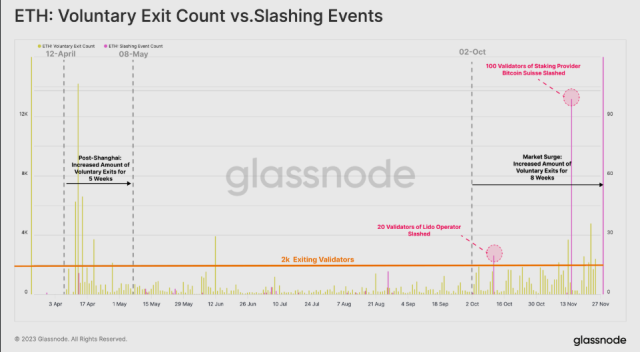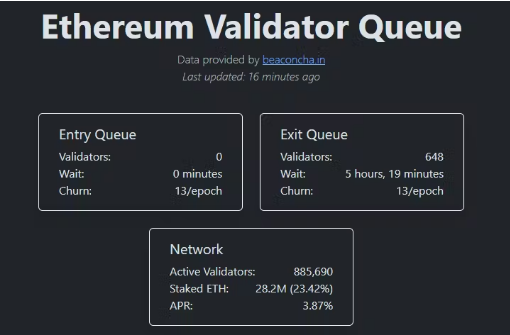Latest news about Bitcoin and all cryptocurrencies. Your daily crypto news habit.
Ethereum’s staking pool dynamics have undergone a significant transformation amidst the buzz surrounding Binance and CZ’s legal challenges and the heightened regulatory scrutiny on centralized exchanges.
Over the past few weeks, there has been a discernible shift in the dynamics of the Ethereum staking pool that indicates a significant slowdown in the rate of validator growth. Due to this change, there was a decrease in the daily issuance of Ethereum (ETH), which was a direct result of the volume of ETH that was actively staking in the pool.
Ethereum Validator Exodus: What’s Going On?
According to Glassnode’s analysis, there has been a high level of about 1,018 validator exits every day since early October, which has coincided with an increase in spot prices for cryptocurrencies. With this movement, Ethereum’s Proof-of-Stake (PoS) consensus mechanism has experienced its first decline in Total Effective Balance since the update.
Over the last eight weeks, the vast majority of the departing validators have willingly withdrawn. Meaning that rather than slicing, which is the punishment meted out to validators that break protocol, the stakers freely choose to leave the staking pool.
There have only been two cases of slashing throughout that time, one of which was important and involved the slashing of 100 validators who had newly joined and were fined for signing two separate blocks within the network at the same time.
Examining The Voluntary Exits
It takes a minimum of 32 ETH to stake in order to act as a validator on the Ethereum network. The number of unique addresses holding this much ETH has been steadily declining since the start of the October rise.
The majority of exits reported during the previous eight weeks, according to Glassnode, were voluntary. When validators independently choose to leave the ETH 2.0 staking pool, it is considered that they have left the network freely.
Approximately 125,189 addresses held at least 32 ETH as of this writing, a 1% decrease from October 1st.
Even with these departures, Kraken and Coinbase, among others, saw a recovery in their balances following Zhao’s resignation, suggesting that users still have faith in these services.
Additionally, the increase in the daily burning of ETH fees through EIP1559 coincides with the change in the issue of ETH. The London upgrade in 2021 set off this fee-burning mechanism, which caused the ETH supply to become deflationary once more.
As the Ethereum network adapts to post-upgrade circumstances, it is going through a dynamic phase. The departures of validators and the shift in staked capital are indicative of how the cryptocurrency markets are changing and how investors are adapting their strategy to take advantage of new possibilities and developments in the market.
Featured image from Freepik
Disclaimer
The views and opinions expressed in this article are solely those of the authors and do not reflect the views of Bitcoin Insider. Every investment and trading move involves risk - this is especially true for cryptocurrencies given their volatility. We strongly advise our readers to conduct their own research when making a decision.

